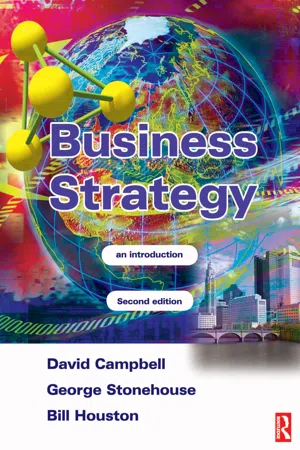
Business Strategy
George Stonehouse, Bill Houston
- 475 pagine
- English
- ePUB (disponibile sull'app)
- Disponibile su iOS e Android
Business Strategy
George Stonehouse, Bill Houston
Informazioni sul libro
'Business Strategy: an introduction' is an accessible textbook that provides a straightforward guide for those with little or no knowledge of the subject. It presents complex issues and concepts in a clear and compact manner, so that readers gain a clear understanding of the topics addressed. The following features are included: * A comprehensive introduction to the subjects of business strategy and strategic management
* Complex issues explained in a straightforward way for students new to this topic
* Student friendly learning features throughout
* Case studies of varying lengths with questions included for assignment and seminar work
* A discussion of both traditional theory and the most recent research in the fieldThis second edition features new and updated case studies as well as more depth having been added to the material in the book. New chapters on business ethics, types and levels of strategy, and how to use case studies have been incorporated. A range of pedagogical features such as learning objectives, review and discussion questions, chapter summaries and further reading are included in the text resulting in it being a user-friendly, definitive guide for those new to the subject.A web-based Tutor Resource Site accompanies the book.
Domande frequenti
Informazioni
Chapter 1 Strategy and strategic management
Introduction and chapter overview
Learning objectives
- define the word strategy using Mintzberg's five Ps framework;
- distinguish between deliberate (prescriptive) and emergent strategy;
- explain what strategy contains in practice;
- describe the different frameworks by which strategy is understood;
- describe what is meant by strategic, tactical and operational decisions;
- explain what is meant by hierarchical congruence and why is it important;
- explain the stakeholder model to show how strategic decisions are arrived at.
What is strategy
Definition
Definitions
Mintzberg's 5 Ps
- a plan;
- a ploy;
- a pattern of behaviour;
- a position in respect to others;
- a perspective.
Plan strategies
Ploy strategies
Pattern strategies
Indice dei contenuti
- Cover Page
- Half Title Page
- Title Page
- Copyright Page
- Contents
- Preface
- Part I An introduction to the strategic process
- Chapter 1 Strategy and strategic management
- Part II Internal analysis
- Chapter 2 The business organization: competences and activities
- Chapter 3 Human resources and culture
- Chapter 4 Financial analysis and performance indicators
- Chapter 5 Products and markets
- Part III External analysis
- Chapter 6 Analysis of the macroenvironment
- Chapter 7 Analysis of the competitive environment
- Chapter 8 Competitive advantage: strategies, knowledge and core competences
- Part IV Strategic implementation and management
- Chapter 9 Evaluation and selection of strategies
- Chapter 10 Strategic implementation
- Chapter 11 Strategic development: directions and mechanisms
- Chapter 12 Quality, operations, performance and benchmarking
- Chapter 13 International and global strategies
- Chapter 14 Social responsibility and business ethics
- Chapter 15 Strategic management: present and future trends
- Part V Case studies
- Learning outcomes grid
- Suggested case questions
- 1 Pilkington and its float glass innovation
- 2 The UK decorative paint industry
- 3 Ben & Jerry's Homemade Ice Cream Inc. ‘A new corporate concept of linked prosperity'
- 4 Who owns Newcastle United?
- 5 Food retailing in the UK
- 6 Derwent Valley Foods Ltd The early years (1981–88)
- 7 Kwik Save Group plc (A)
- 8 Kwik Save (B): Somerfield
- 9 The UK outbound tour operations industry
- 10 MyTravel plc (formerly Airtours) Competing in the travel industry big league Nigel Evans
- 11 Honda–Rover: how successful was it?
- 12 Amazon.com
- 13 Strategic alliances in the airline industry
- 14 The Gulf War (1990–91)
- Glossary of key terms
- Index